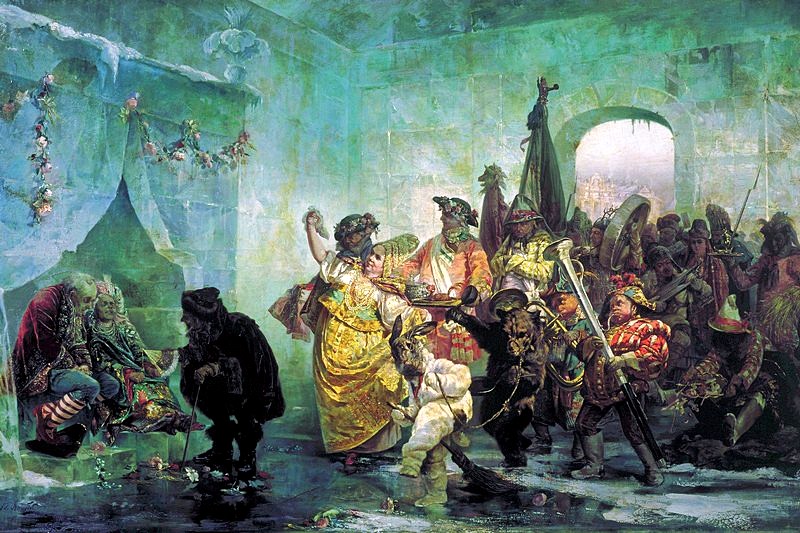Anna Ioannovna

Born: Moscow, 28 January (7 February) 1693
Died: St. Petersburg, 17 (28) October 1740
Reigned: 1730-1740
Anna was born in Moscow to Tsar Ivan V and Praskoviya Fyodorovna Saltykova. After the death of her father, she lived with her mother and sisters in the village of Ismaylovo, where she was educated at home. In 1708, the entire family moved to Petersburg, and two years later Anna married Friedrich Wilhelm, Duke of Courland, who was the nephew of the Prussian King. Shortly thereafter, the Duke died, although Anna, at the order of Peter the Great, continued to live in Mitau (the modern city of Elgava in Latvia) under the supervision of the Russian representative, Peter Bestuzhev-Ryumin, who headed the duchy and for many years was Anna's lover.
In 1726, arrangements were made for Anna to marry the son of the Polish king, Count Maurice of Saxony, but these plans were scuttled due to the influence of Prince Alexander Menshikov, who himself wanted to become the Duke of Courland, and Anna never remarried. In 1718, Ernest Johann von Biron entered Anna's service, and, quickly becoming her favorite, came to play a significant role not just in her fate, but in the history of Russia as well.

After the death of Peter II, the Supreme Privy Council, which consisted of the most powerful nobles, offered the Russian throne to Anna. She was attractive to the Council in that she was a widow, lived in Courland, and had no favorites in Russia. The members of the Council thus hoped to limit the absolute authority of the new Empress, who they hoped would be little more than a figurehead. To this end, before ascending the throne, Anna was induced to sign the so-called "Conditions", according to which power would be concentrated in the hands of the Supreme Privy Council. Without the Council's consent, the monarch was not allowed to enter marriage, declare war, or name an heir to the throne.
Arriving in Moscow and receiving the oath from the nobles and the army, Anna quickly realized the strength of her position and within one week invalidated the "Conditions" and became an autocratic Empress. At first she tried to take interest in affairs of state, but this soon faded. Instead, she depended upon her favorite Ernst Johann von Biron, who rapidly gathered influence and virtually became the unofficial ruler of Russia. After coming to power, Anna dissolved the Supreme Council, replacing it one year later with the Cabinet of Ministers, which included such notables as Alexey Cherkassky, Gavriil Golovkin, and Andrey Osterman.

Under the influence of Biron, who quickly became the Duke of Courland and was the first minister and chief advisor to the Empress, the most important positions in the government and the army were given increasingly to foreigners, who also moved up the ranks rapidly. This, of course, caused resentment among many Russians, who linked all abuses of power to this domination by foreigners. The quiet murmurings on the part of her subjects made the Empress quite fearful of conspiracies, and she quickly established the Secret Chancellery (The Chancellery of Secret Investigation of Cases), which arrested and tortured within its walls the discontented and the suspicious. Among the Chancellery's victims who were executed during the Anna's reign were the Dolgorukov princes, participants in the Volynsky Conspiracy, and many others.
During Anna's reign, Peter the Great's primogeniture law was repealed, which meant that estates could once again be subdivided, and compulsory military or civil service for nobles was restricted to twenty-five years. In St. Petersburg, the Sea Cadet Corps Institute was founded. The military was also reorganized under the supervision of Field Marshal Burkhard Christoph von Munnich, and two new Guards Regiments were formed: the Ismailovsky and the Horse Guards. From 1735 to 1739, Russia was embroiled in war with the Ottoman Empire, which ended unfavorably for Russia with the Peace of Belgrade. During Anna's reign, Russia also defeated the Crimean Khanate, and helped place Stanislaus Augusts, Elector of Saxony, on the Polish throne.

Meanwhile, the Empress, having placed governmental affairs in the hands of Duke von Biron, indulged herself in the pleasures of courtly life. According to contemporary descriptions, Anna was not particularly attractive and had rather unrefined tastes. She kept abreast of all rumours and gossip, surrounded herself with jesters, was superstitious, liked to dress colorfully, often organized hunts, and in the breaks between hunting trips, simply shot at birds in the parks of her palace estates. Contemporaries remembered not only the horrors of the Secret Chancellery, but luxurious court ceremonies, such as the entry of her court into Petersburg and elaborate pranks such as the public humiliation of the aged Prince Golitsyn, who was forced to spend his wedding night naked in a specially constructed "Ice Palace."

Not long before her death, Empress Anna named as her successor Prince Ivan Antonovich (the son of her niece Anna Leopoldovna and Anton Ulrich, Duke of Brunswick), who at that moment was only two months old. It was decided that until the boy reached adulthood, von Biron would serve as regent. The childlessness of reigning monarchs and the suppression of the direct male line of descendants to the Russian throne would soon lead to the "Age of Palace Coups."
In 1740, while dining with Biron, Anna felt unwell and lost consciousness. She died soon afterwards. Anna is burried in the Cathedral of the Peter and Paul Fortress in St. Petersburg.

